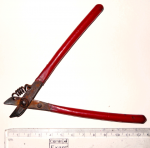Difference between revisions of "Network Security"
Jump to navigation
Jump to search
BobJonkman (talk | contribs) (Add Meetup URL and iCal link) |
BobJonkman (talk | contribs) m (Unlink Nipper Tool image from Wikipedia) |
||
| Line 20: | Line 20: | ||
==== Resources ==== | ==== Resources ==== | ||
* Firewalls | * Firewalls | ||
| − | ** The most secure firewall: [[File:Nipper for Electronic Wire (Old).png|150px | + | ** The most secure firewall: [[File:Nipper for Electronic Wire (Old).png|150px]] |
** Another secure firewall: [https://www.pfsense.org/ pfSense] | ** Another secure firewall: [https://www.pfsense.org/ pfSense] | ||
* Intrusion Detection Software | * Intrusion Detection Software | ||
Revision as of 03:50, 2 January 2019
Network Security
- Date
- Monday, 11 March 2019 from 7:00pm to 9:00pm iCal
- Meetup Event
- https://www.meetup.com/NetSquared-Kitchener-Waterloo/events/257702185/
- Location
- TBA
We've talked about Malware and the importance of Keeping Computers Up To Date, and even just about The Things We Should Fear. But what new hazards are unveiled when you connect two or more computers together? When some of those computers aren't on your own network? When malusers are out there trying to break into your network? When you're actually inviting everyone into your network by running servers and services? Should you just outsource everything? Or are there tools available for the Non-Profit SysAdmin to help secure your networks?
We'll talk about the hazards of running a public network, and go over a list of tools and software.
--Marc Paré & Bob Jonkman
Resources
- Firewalls
- The most secure firewall:

- Another secure firewall: pfSense
- The most secure firewall:
- Intrusion Detection Software
- Pen Testing apps